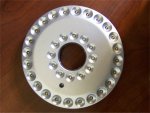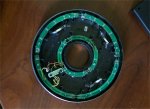lbenson
Senior Member
I recently got from Dealextreme several of the "flying saucer" LED lights shown in the pictures. These are for camping (in my Oz-made Kamperoo tent trailer). They run off of 4 AAs. I would like to put a DPDT switch in them so that I can switch to 5 volts regulated down from a 12-volt auto battery (actually a separate non-lead sealed 18AH). I am concerned about burning them out, since there is not a resistor in sight (and I'm fairly sure that there are not resistors contained in the switch, tho there could be).
The switch has 3 "on" positions--outer ring, inner ring, both rings. The LEDs are wired in parallel. Since there appear to be no resistors, can it be that the device relies upon the discharge rate of the battery to keep from burning out the LEDs? I unsoldered and removed one of the 3-LED inner PCB strips, and hooked it up through a 220R--it seemed not as bright as on the device. I then hooked it up without the resistor--the lights were much brighter, and within 5 seconds were getting warmish, so I assume the LEDs are not resistorized.
There are 24 LEDs in the outer ring and 12 in the inner. Sorry, Dippy, no data sheets are available. How can I safely wire up the 12-volt battery, regulated down to say 5 volts with, say, a LM2940CT-5 1-amp regulator (beefy enough? max 36*20ma = 720ma)?
The switch has 3 "on" positions--outer ring, inner ring, both rings. The LEDs are wired in parallel. Since there appear to be no resistors, can it be that the device relies upon the discharge rate of the battery to keep from burning out the LEDs? I unsoldered and removed one of the 3-LED inner PCB strips, and hooked it up through a 220R--it seemed not as bright as on the device. I then hooked it up without the resistor--the lights were much brighter, and within 5 seconds were getting warmish, so I assume the LEDs are not resistorized.
There are 24 LEDs in the outer ring and 12 in the inner. Sorry, Dippy, no data sheets are available. How can I safely wire up the 12-volt battery, regulated down to say 5 volts with, say, a LM2940CT-5 1-amp regulator (beefy enough? max 36*20ma = 720ma)?
Attachments
-
47.7 KB Views: 33
-
59.4 KB Views: 37


